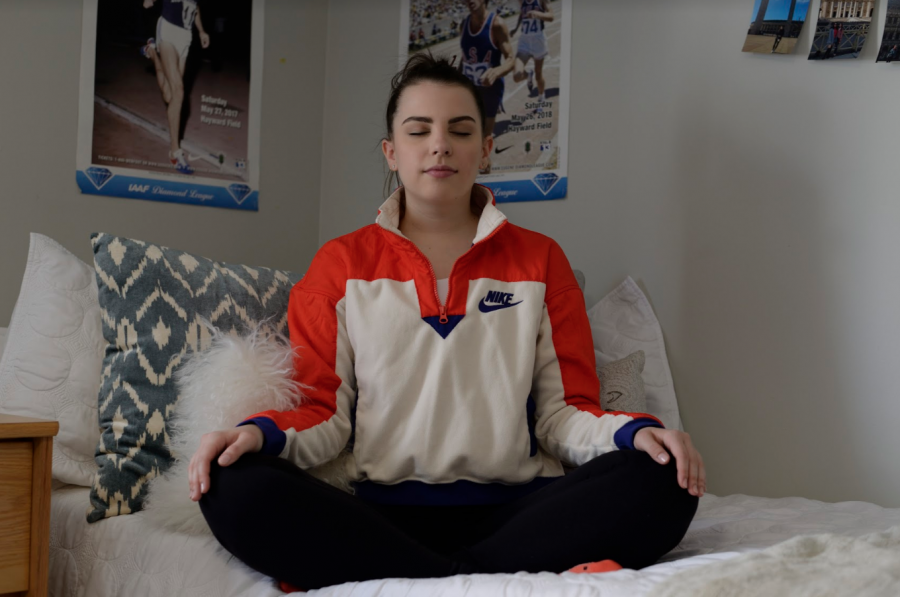Meditation: More Than Just a Pose In a Silent Room
February 19, 2019
For the past few months, I have seen many people on social media talk about meditation — so much that I might even say it is trending. Some people talk about using it as a way to clear their minds in the morning and start their days off on the right foot. Some use it for anxiety, some for sleep. I wanted to see what the hype is all about, so I tried meditating once a day for a week. This is what I learned.
At first, incorporating meditation into my daily routine was a struggle. I have been wanting to work on my sleeping habits, so I thought I would try using meditation to wind down and get myself ready to go to sleep. I recently downloaded the meditation app, Headspace, which has an annual fee of $9.99 for students. I searched the app for guided sleep meditation. There were many different routines to choose from, most ranging from three to 20 minutes. I chose a basic 10-minute exercise intended to “create the conditions for a restful night’s sleep,” put my headphones in and laid down on my bed.
The overall experience of the guided meditation for sleep was tranquil because I didn’t have to do anything but listen to the voice of an Australian man on the recording. The guided meditation would have been more successful with no distractions and if I was more tired or experienced with mediation. It was hard because I live with roommates and we aren’t always all on the same page about winding down for the evening. I decided to try meditating at a different time the next day.
On my second day, I started meditating in the morning, but I quickly learned that next time I would need to try meditating after having some coffee. One of the main things I learned in my week of daily mediation was that it is almost impossible to focus on meditating when you would rather be sleeping. Meditating right after waking up or right before going to bed is going to end in you falling asleep.
I also quickly learned to not force meditation. When I tried to squeeze mediating into a busy morning routine or even at night — when what I really needed was just to go to sleep — I could not focus. The goal of most of the guided meditations I used from Headspace or found on YouTube was to focus on deep breathing, getting rid of negative thoughts and how my body felt in the moment.
When I was rushing around trying to finish an assignment, eat breakfast and get ready all before class in the morning, I was not able to accomplish any of those goals while meditating. My mind was elsewhere. During the last few days of daily meditation, I stopped scheduling it in and meditated when I needed a break or when I had some down time during the school day.
I found meditation to be most beneficial for me when I approached the practice in this way. I meditated when I felt stressed out or had gotten overwhelmed from sitting at my computer cranking out assignments. These instances are when I was able to get into the meditations the most. Throughout the week I stuck to guided meditations because I am still a beginner, but realized I could use the techniques from guided meditation when I didn’t have time to find one. This routine is what I will continue to do based off of my experiences this week.
I liked using Headspace when I had a specific reason I wanted to meditate, like when I felt anxious, restless or stressed out. Since I have the yearly membership now, I intend to keep using it. Some of the breathing techniques and overall mindfulness I learned from the guided meditations are aspects I will try to incorporate regularly into my day-to-day life.
To complement my week of meditation, I spoke to Kate Hoover, an intern for the Office of Counseling and Psychological Services at Fordham, where she is also pursuing her master’s degree. Hoover has been practicing Zen Buddhist meditation for 10 years. This meditation, called zazen, is typically a 30-minute seated silent meditation. Hoover said, “the core practice is counting the breath, noting when you become distracted and then starting over at one. It’s rare to reach the goal of 10, and that’s okay — the practice is really in learning to continue coming back to the breath with compassion.”
Meditation does not have to be that complex, though. I asked Hoover for some tips for people interested in beginning to meditate. “Start small,” she said, “start with what’s realistic for your schedule. If you have five minutes, take the five minutes; you don’t need to jump into this massive 30-minutes, three-times-a-day plan. Just do what makes sense and you can build up from there.” Meditation does not have to be complicated. It can just be taking a few minutes to focus on breathing.
Hoover used a metaphor that I really liked when it comes to starting out in meditation. She said, “Treat yourself like you would treat a small child that you like. If thoughts come up, don’t scold yourself. Don’t pretend like it’s not happening. Just gently say, not right now, let’s come back to the breath.”
The last and biggest realization I had from my week of meditation was to be more mindful and take more time for myself overall. Hoover summed up the importance of this as well. She said, “It’s helpful to learn how to take a step back and check in on how you’re doing. It lets you notice if you’re feeling stressed or worked up, which helps you see when self-care is needed.”
For students interested in trying meditation, the Office of Counseling and Psychological Services is sponsoring a Koru mindfulness and meditation course. Hoover described the course as “a good way to manage stress and gain focus with classes specifically designed for college students.” Beginning on Tuesday, Feb. 16, the course will run for four weeks and meets on Tuesdays from 2:15 to 3:30 p.m.














